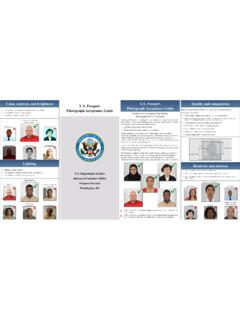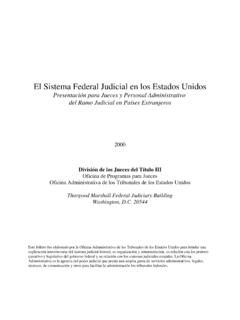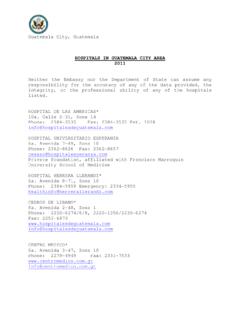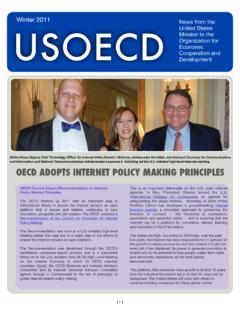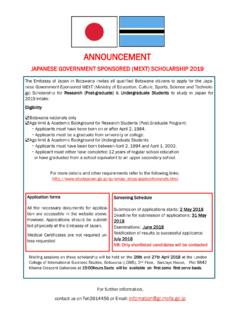Transcription of Doing Business In Botswana: A Country Commercial …
1 Doing Business In botswana : A Country Commercial Guide for Companies INTERNATIONAL COPYRIGHT, & FOREIGN Commercial SERVICE AND DEPARTMENT OF STATE, 2012. ALL RIGHTS RESERVED OUTSIDE OF THE UNITED STATES. Chapter 1: Doing Business In botswana Chapter 2: Political and Economic Environment Chapter 3: Selling Products and Services Chapter 4: Leading Sectors for Export and Investment Chapter 5: Trade Regulations and Standards Chapter 6: Investment Climate Chapter 7: Trade and Project Financing Chapter 8: Business Travel Chapter 9: Contacts, Market Research and Trade Events Chapter 10: Guide to Our Services Chapter 1: Doing Business In botswana Market Overview Market Challenges Market Opportunities Market Entry Strategy Market Overview Return to top Ranked number one in Africa on Transparency International s anti-corruption index, botswana is a stable democratic Country which has historically enjoyed among the highest economic growth rates in the world.
2 botswana s ranking on the annual World Bank/IFC Doing Business report was 52 out of 183 countries globally. Its score compared favorably to all other African countries except Rwanda (ranked 45), South Africa (ranked 35) and Mauritius (ranked 23). In 2011, Moody s credit rating agency upgraded botswana 's rating from negative to stable, and retained the A2 rating for foreign and domestic bonds. The upgrade reverses Moody s decision in February 2010 to assign a negative outlook following the deterioration of botswana s net asset position as a result of the global economic slowdown. botswana s diamond mining industry dominates the economy: As of the third quarter of 2011, mining contributed to 32 percent of overall GDP, and it supplies about a third of the government s total revenue. Despite mining s great contribution to the Country s wealth, the sector only accounts for about 5 percent of employment.
3 botswana s economy is among the most skewed in the world between rich and poor, and an estimated 23 percent of botswana s population survives on less than $ Largely due to diamond revenue, botswana enjoyed the highest GDP growth rate in the world from 1970 to 1999 ( percent). Its economy contracted somewhat in the wake of the global financial crisis, but recovery is well underway. Real GDP grew by percent in the third quarter of 2011 and is expected to grow by percent in 2012. The non-mineral GDP growth rate for 2012 is estimated to be percent. botswana s mining revenue has provided the government with resources to construct and maintain a solid infrastructure, including roads, telecommunication systems, hospitals, hotels, and schools. The presence of a well-maintained infrastructure, complimented by political stability, tends to encourage foreign investment.
4 The manufacturing sector is small, accounting for about four percent of GDP, and is focused on the small downstream diamond industry. Agriculture accounts for even less of botswana s wealth, with only about two percent of GDP, but in the third quarter of 2011 recorded a year-on-year growth rate of 10 percent. Services represent about 10 percent of GDP, and the Government of botswana is the major buyer in the Country , with central government expenditures accounting for 31 percent of GDP. Tourism is a growing sector, accounting for about six percent of GDP. Recently, public debt has increased and represents about 14 percent of GDP. Recent studies by the World Bank and IMF have called for stringent control of public expenditure for long term budget sustainability. To restore fiscal discipline, the budget for fiscal year 2011/12 recommended expenditure cuts and continued belt tightening which will result in a projected budget surplus of some $153 million by 2013.
5 Some have questioned the government s political will to cut the deficit and reign in spending significantly. However, these concerns are dissipating: In 2010 the government froze wages for government employees (which make up roughly half of total employment), the last three annual budget papers have emphasized Doing more with less, and the latest budget projects a surplus. In 2011, an eight week public sector strike tested the government s approach to fiscal discipline. Despite strong pressure to meet worker demands for a 16 percent wage increase, the botswana government held firm, and public sector workers returned to work with only a three percent increase. The Pula depreciated against the major international currencies in 2011. Although the Pula s depreciation limits the growth of imports generally, demand for particular imported goods and services especially infrastructural developments and mining projects should remain strong.
6 Domestic inflation rose from percent in December 2010 to percent in December 2011. In 2011, the botswana consumer experienced increased fuel prices, public transport fares, and electricity tariffs. The government anticipates that inflation will be contained, however, and fall within the Bank of botswana desired range of 3-6 percent in the second half of 2012. Government trade statistics show total exports to botswana of $ million in 2011, of which the bulk was machinery and transport equipment, generators, military, and telecommunications equipment. imports from botswana totaled $293 million in 2011. As many products enter botswana as re-exports from South Africa, the export figure does not represent the total consumption of US goods in the Country . Similarly, the import figure does not include most diamonds, which generally enter the as re-exports from the United Kingdom.
7 The major export opportunities for botswana continue to be in the area of mining equipment, hospital/medical equipment and supplies, aircraft equipment, pharmaceuticals, generators, telecommunications equipment and supplies, computer hardware and software, solar energy equipment, and financial and consulting services. botswana is a member of the Southern African Development Community (SADC), a regional intergovernmental organization of fifteen African states. The SADC Trade Protocol provides each member state most favored nation treatment on import and export duties. SADC members have not yet negotiated a Free Trade Agreement eliminating tariffs but there is a commitment to develop one. FTA negotiations between the United States and the region were suspended in 2006. botswana is also a member of the Southern African Customs Union (SACU), which consists of botswana , Lesotho, Namibia, Swaziland, and South Africa.
8 Customs and excise duties in SACU are pooled and distributed according to a revenue sharing formula. Historically, payments from SACU have represented a large proportion of botswana s total public sector revenues (in 2008, for example, it was 25 percent). But revenues from this source have declined from 2007 to the present. Should member states revise the revenue sharing formula as they are set to do in the near future (South Africa pays the most and has grown frustrated with its role subsidizing the smaller economies), this decline will accelerate. botswana has had a democratically-elected government since independence in 1966. Democratic institutions are in place and function well. Parliamentary elections held in October 2009 were free and fair. The next general election is expected in October 2014. botswana and the enjoy excellent bilateral relations.
9 Market Challenges Return to top More than 800 companies do Business in neighboring South Africa, and market observers in the region often wonder why more of them are not also Doing Business in democratic, stable, and easily reachable botswana . The reason cited most often is the small size of botswana s market. With a population of only 2 million, botswana , for many companies, does not represent the sizeable market opportunity that would justify the extra time and expense required in Doing Business across an international border and in another jurisdiction. An FTA between the fifteen SADC member states and the unification and simplification of laws, regulations and procedures still years away would change that equation by encouraging observers to think in terms of entering botswana as a gateway to the SADC market of 277 million people and a convenient central location from which to do Business , well connected by transport corridors to neighboring states.
10 The next most frequently cited market challenge is the narrow skills base of botswana workers. Partly due to the Country s small population, and partly due to lack of opportunities for workers to gain experience and training, botswana offers too few experienced managers and specialists. Most investors find they must retain expatriates to fill these roles. This poses its own problems, as work and resident permits for expatriate employees are subject to bureaucratic delays and hurdles. Other market challenges commonly cited are regulatory constraints in certain sectors which have little or no relationship to the protection of the public interest; excessive red tape and overly bureaucratic and outdated procedures for obtaining licenses and permits; limited access to finance; high cost of high-speed internet; high cost of energy (although this cost is expected to stabilize as botswana begins to provide for its own energy needs); poor customer service; and low worker productivity.
